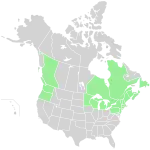| Hieracium lachenalii | |
|---|---|
 | |
| Scientific classification | |
| Kingdom: | Plantae |
| Clade: | Tracheophytes |
| Clade: | Angiosperms |
| Clade: | Eudicots |
| Clade: | Asterids |
| Order: | Asterales |
| Family: | Asteraceae |
| Genus: | Hieracium |
| Species: | H. lachenalii |
| Binomial name | |
| Hieracium lachenalii | |
 | |
| Hieracium lachenalii distribution | |
| Synonyms[2] | |
|
Synonymy
| |
Hieracium lachenalii, also known as common hawkweed or yellow hawkweed, is a species of plant in the tribe Cichorieae within the family Asteraceae. It is native to Europe but has become established as a weed in Australia and parts of North America. The species was widely known for many years as H. vulgatum,[3] but more recent studies have indicated that the two names represent the same species. The name H. lachenalii was coined in 1802,[4] H. vulgatum in 1819,[5] so the older name is to be used.[6]
Description
This common weed can grow and produce flowers on plants that range from 4 inches (10 centimeters) to 36 inches (91 cm) tall. The rhizome is short and stout. The broadly elliptic leaves can be up to 5 inches (13 centimeters) long and taper with teeth towards the base.[7] Each flower head has 40-80 ray florets but no disc florets[8][9] Bracts surround the flower head; the receptacle (basal part of the flower on which the florets are attached) is flat and naked; heads tend to start together then become somewhat solitary on long leafless stems.[8] The stalks below the heads are covered with scattered, simple and gland-tipped black hairs and contain a milky substance.[9]
The pale yellow flowers are produced during all of the summer months. The fruit are dark brown achenes.[7]
Common names
- Croatian: Obična runjika
- Dutch: Gewoon havikskruid
- German: Gewöhnliches Habichtskraut, Lachenals Habichtskraut
- English: Common Hawkweed, Yellow Hawkweed
- French: Epervière de Lachenal
- Hungarian: Közönséges hölgymál[10]
- Italian: Sparviere comune
- Latvian: Jakarda mauraga
- Polish: Jastrzębiec Lachenala
- Serbian: Maslačak
- Slovene: Lachenalova škržolica, Navadna škržolica
- Russian: Ястребинка Жаккара[11]
- Welsh: Heboglys
- Swedish: Hagfibbla
Distribution and habitat
Native to most of Europe,[11] Hieracium lachenalii was introduced to cooler parts of North America,[12] and to Australia.[8] It can sometimes be found in soils that have been disturbed.[13]
Europe
Austria, Belarus, Belgium, Bosnia-Herzegovina, Channel Islands, Republic of Croatia, Corsica, Czech Republic, Denmark, Estonia, France, Finland, Germany, Republic of Hungary, Ireland, Italy, Latvia, Principality of Liechtenstein, Lithuania, Grand Duchy of Luxemburg, Montenegro, Netherlands, North Macedonia, Republic of North Ossetia–Alania, Norway, Republic of Poland, Romania, San Marino, Serbia, Slovenia, Slovakia, Sweden, Switzerland, Ukraine, United Kingdom, Vatican City, and various oblasts of Russia:
- Arkhangelsk Oblast
- Astrakhan Oblast
- Belgorod Oblast
- Bryansk Oblast
- Ivanovo Oblast
- Kaluga Oblast
- Kirov Oblast
- Kostroma Oblast
- Kaliningrad Oblast
- Krasnodar Krai
- Kursk Oblast
- Leningrad Oblast
- Lipetsk Oblast
- Moscow Oblast
- Murmansk Oblast
- Nizhny Novgorod Oblast
- Novgorod Oblast
- Orenburg Oblast
- Oryol Oblast
- Penza Oblast
- Perm Krai
- Pskov Oblast
- Rostov Oblast
- Ryazan Oblast
- Samara Oblast
- Saratov Oblast
- Smolensk Oblast
- Stavropol Krai
- Tambov Oblast
- Tula Oblast
- Tver Oblast
- Ulyanovsk Oblast
- Vladimir Oblast
- Vologda Oblast
- Volgograd Oblast
- Voronezh Oblast
- Yaroslavl Oblast
and its autonomous republics:
North America
Subarctic America: Greenland.[14]
Canada: British Columbia, New Brunswick, Newfoundland, Nova Scotia, Ontario, Prince Edward Island, Quebec.[14]
United States: Connecticut, Delaware, Maine, Massachusetts, Michigan, Minnesota, New Hampshire, New Jersey, New York, Oregon, Pennsylvania, Rhode Island, Vermont, Washington, Wisconsin.[14]




References
- ↑ Tropicos, search for Hieracium lachenalii
- ↑ The Plant List, Hieracium lachenalii Suter
- ↑ Flora of North America, Hieracium vulgatum Fries, 1819.
- ↑ The International Plant Names Index, Hieracium lachenalii
- ↑ The International Plant Names Index, Hieracium vulgatum
- ↑ International Code of Nomenclature for algae, fungi, and plants (Melbourne Code), article 11
- 1 2 MSU Board of Trustees; Jesse L Saylor & Network Vista, Inc. "MSUplants.com Hieracium lachenalii". msuplants.com/index.html. Michigan State University Department of Horticulture. Archived from the original on 2008-02-29. Retrieved 2007-12-14.
- 1 2 3 Ian Faithfull (2007-09-19). "Hawkweeds: State Prohibited Weed". Information Notes Series. Department of Primary Industries, Victoria, Australia. Retrieved 2007-12-14.
- 1 2 Mrs. M. Grieve (1933). "Hawkweed, Wood". A Modern Herbal. Botanical.com. Retrieved 2007-12-14.
- ↑ Az ANP (valamint a Gömör-Tornai-karszt magyarországi részének) taxonlistája
- 1 2 3 Botanic Garden; Botanical Museum Berlin-Dahlem (June 5, 2007). "Details for: Hieracium lachenalii". The Euro+Med Plantbase. Botanic Garden and Botanical Museum Berlin-Dahlem. Retrieved 2007-12-14.
- ↑ Biota of North America Program 2014 state-level distribution map
- ↑ Paul Slichter. "Common Hawkweed". Wildflowers of the Genus Hieracium:Hawkweeds of the Columbia River Gorge. Archived from the original on 2004-01-22. Retrieved 2007-12-21.
Common hawkweed may be found in disturbed soils.
- 1 2 3 "Hieracium lachenalii". Germplasm Resources Information Network. Agricultural Research Service, United States Department of Agriculture. Retrieved 2007-12-14.
External links
 Media related to Hieracium lachenalii at Wikimedia Commons
Media related to Hieracium lachenalii at Wikimedia Commons Data related to Hieracium lachenalii at Wikispecies
Data related to Hieracium lachenalii at Wikispecies- Integrated Taxonomic Information System Organization (ITIS) (December 14, 2007). "Hieracium lachenalii". Integrated Taxonomic Information System on-line database. Retrieved 2007-12-14.
- Paul Slichter. "Common Hawkweed". Wildflowers of the Genus Hieracium:Hawkweeds of the Columbia River Gorge. Archived from the original on 2004-01-22. Retrieved 2007-12-21.
- Stonehill College. "Common Hawkweed (Hieracium vulgatum)". Stonehill College Field Guide. Archived from the original on 2006-09-05. Retrieved 2007-12-21.